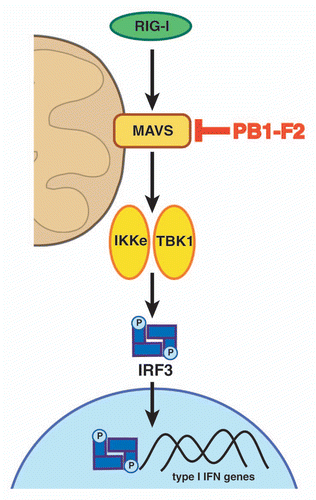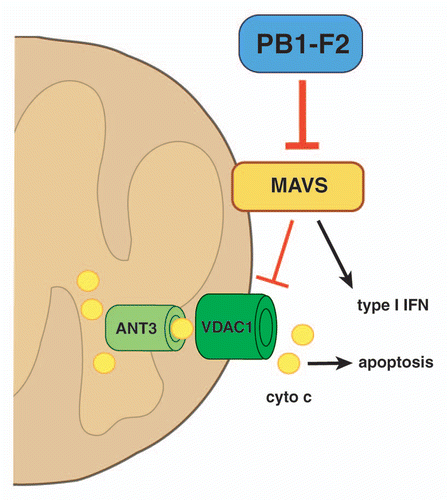Figures & data
Figure 1 The anti-interferon activity of PB1-F2. Upon recognition of viral RNA species, RIG-I interacts with and activates MAVS. This leads to the activation of TBK1 and IKKε which phosphorylate IRFS. The IRF transcription factor complex then translocates to the nucleus to mediate the transcription of type I IFN genes (together with NFκB and ATF/c-Jun, not shown here). Our recent study shows that PB1-F2 inhibits the induction of type I IFN at the level of the MAVS adaptor protein. Please note: schematic is not to scale.

Figure 2 PB1-F2 promotes mitochondrial apoptosis. (A) PB1-F2 can associate with ANT3 and VDAC1 in the inner and outer mitochondrial membrane, respectively, to induce the efflux of cytochrome c (cyto c), which further downstream leads to the activation of caspases. (B) PB1-F2 can also self-oligomerize to form pores in the mitochondrial membrane. Please note: schematic is not to scale.

Figure 3 Model for the molecular bridge of the pro-apoptotic and anti-interferon functions of PB1-F2. MAVS is an important mediator of the type I IFN production pathway. It has also been shown that MAVS has a negative regulatory effect on VDAC1-mediated apoptosis. PB1-F2 affects MAVS-mediated IFN production by possibly binding to MAVS, which may have two effects: (1) the inhibition of the type I IFN response and (2) the lifting of the inhibitory effect of MAVS on VDAC1-mediated cell death. Please see text for further details and discussion. Please note: drawing is not to scale.
